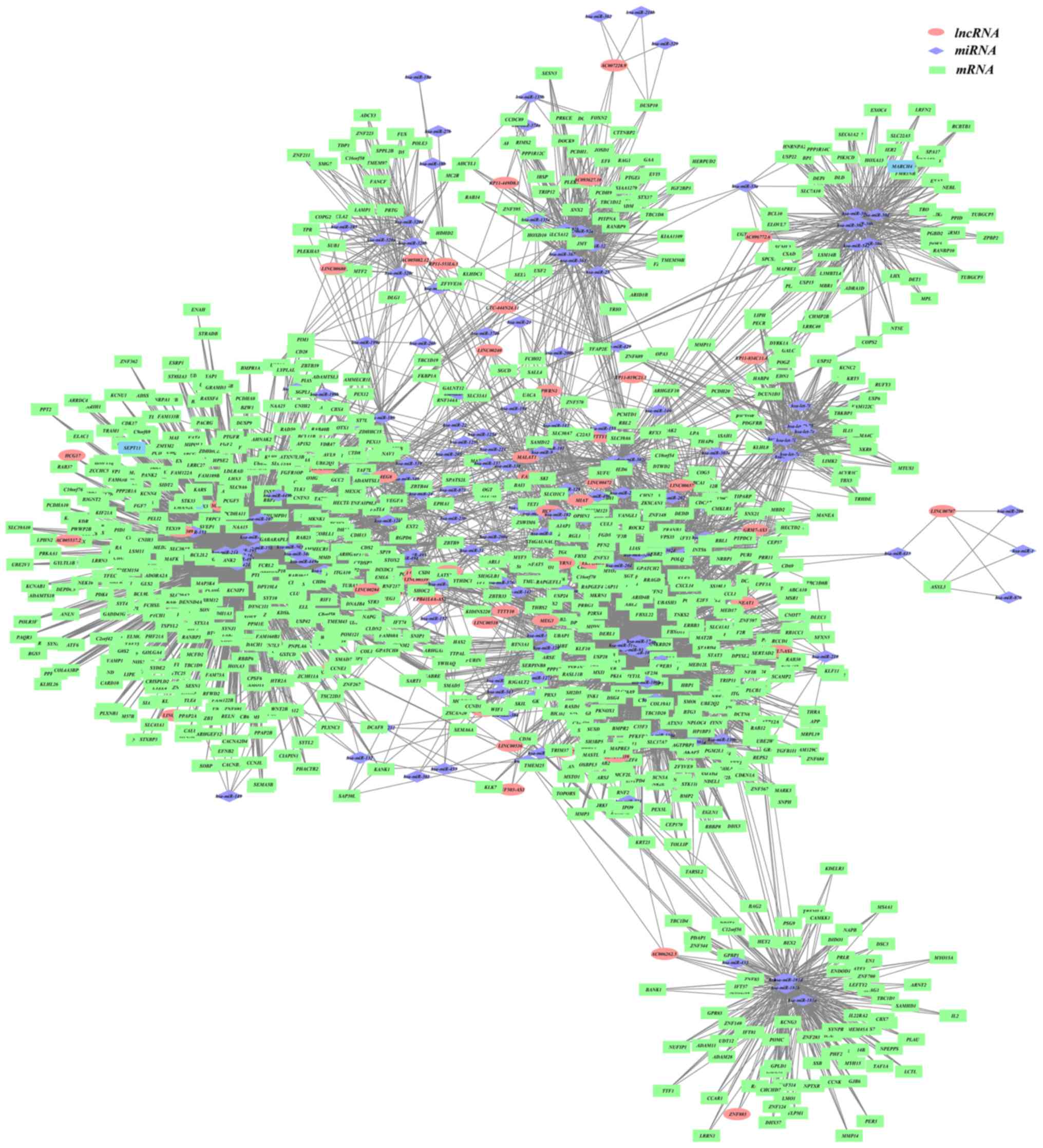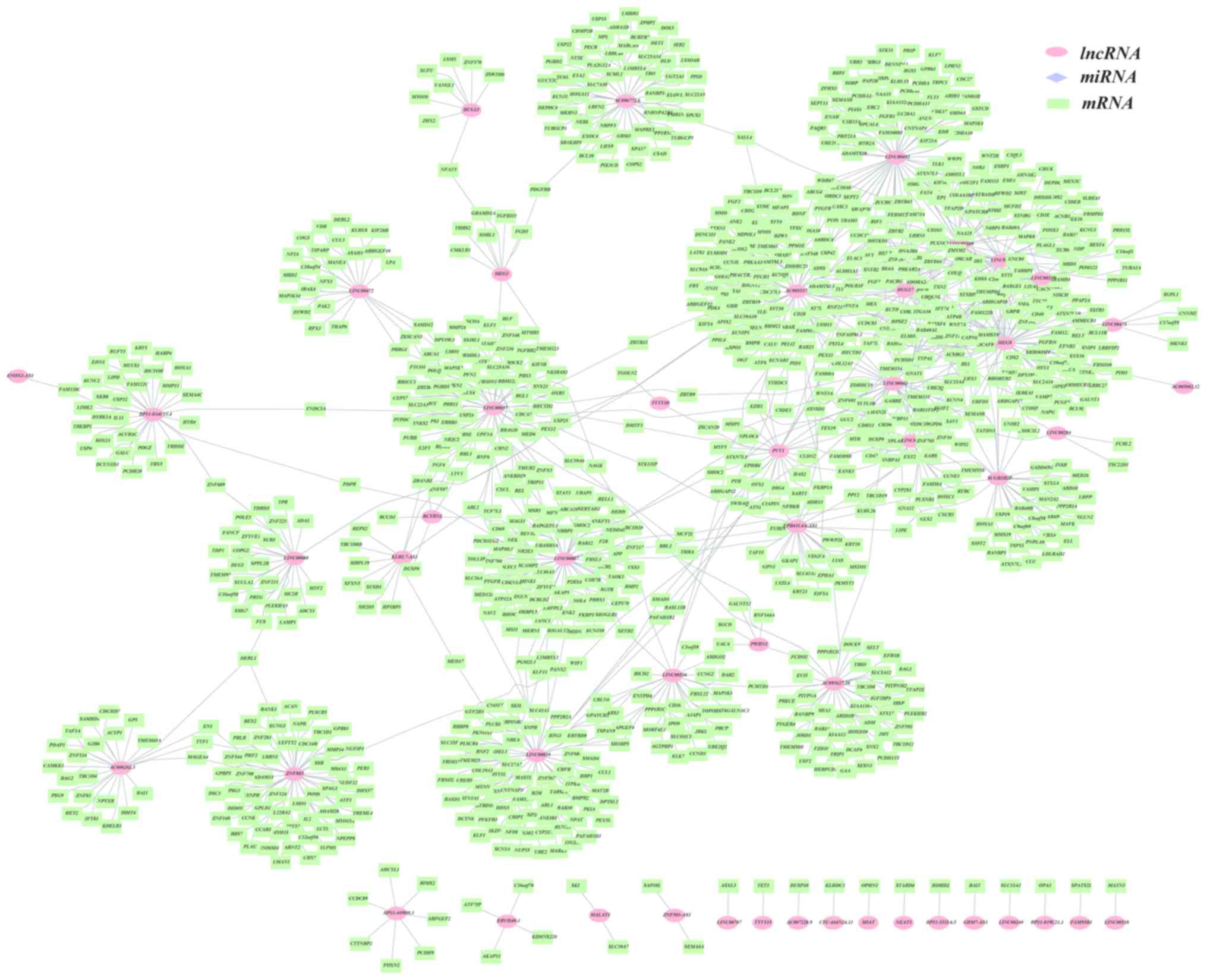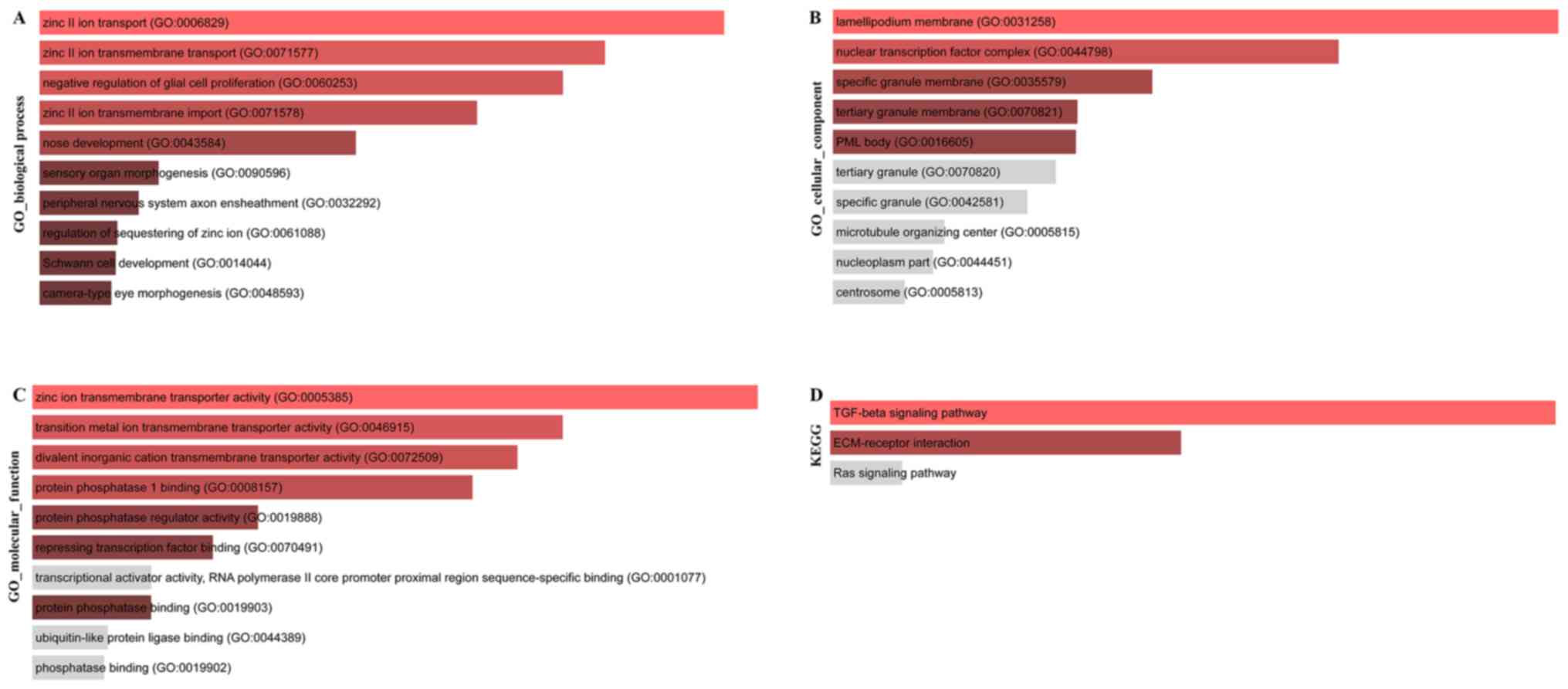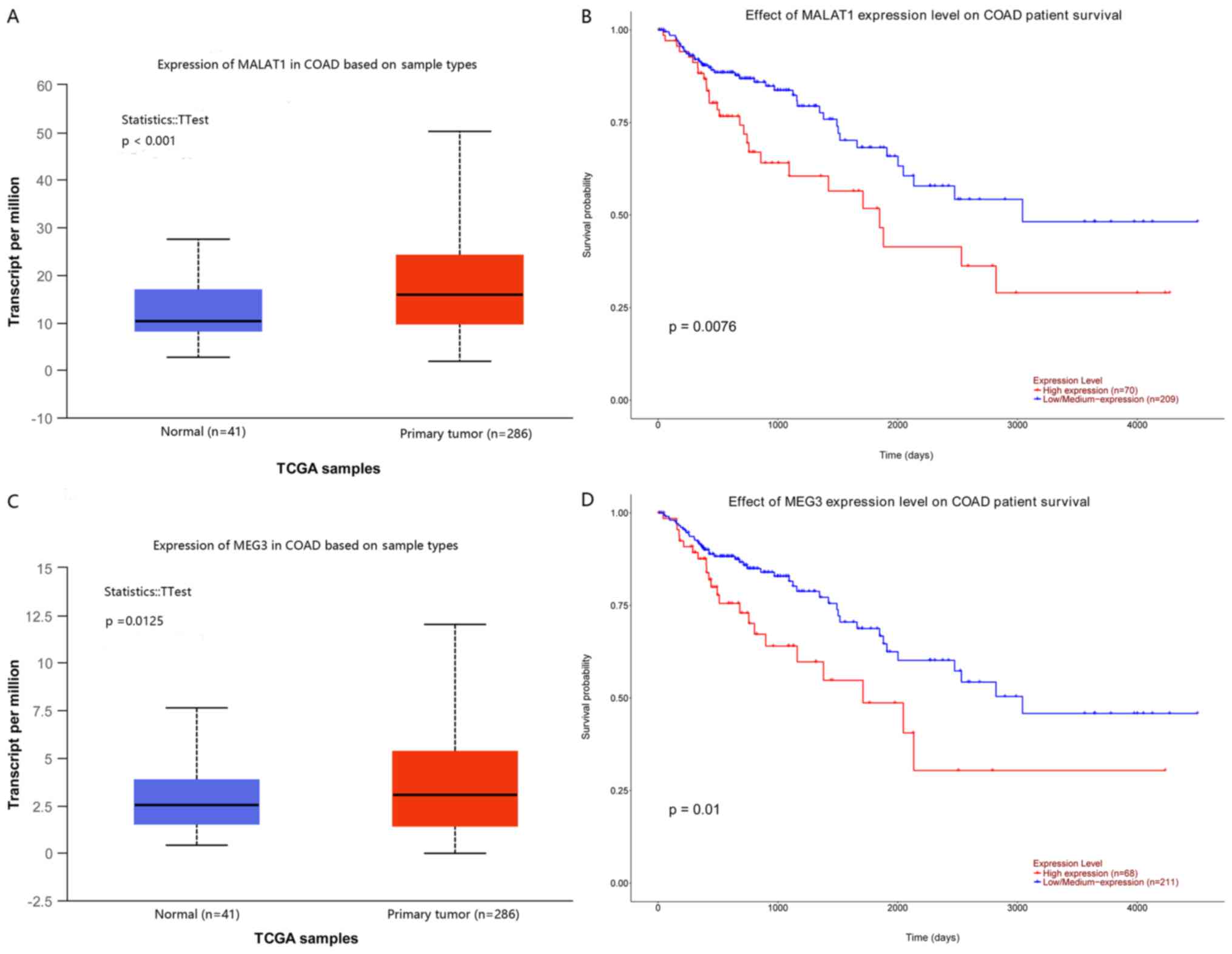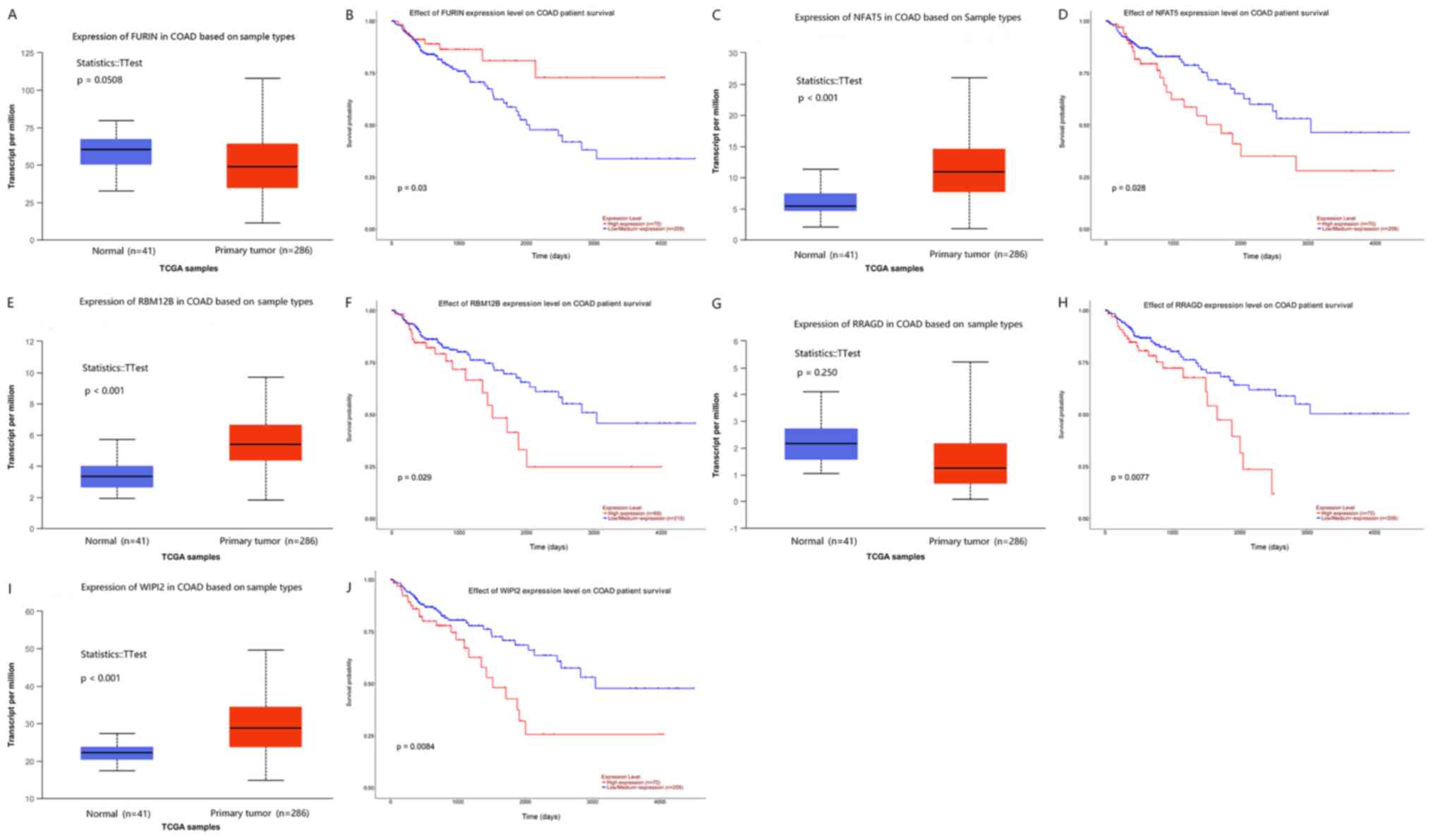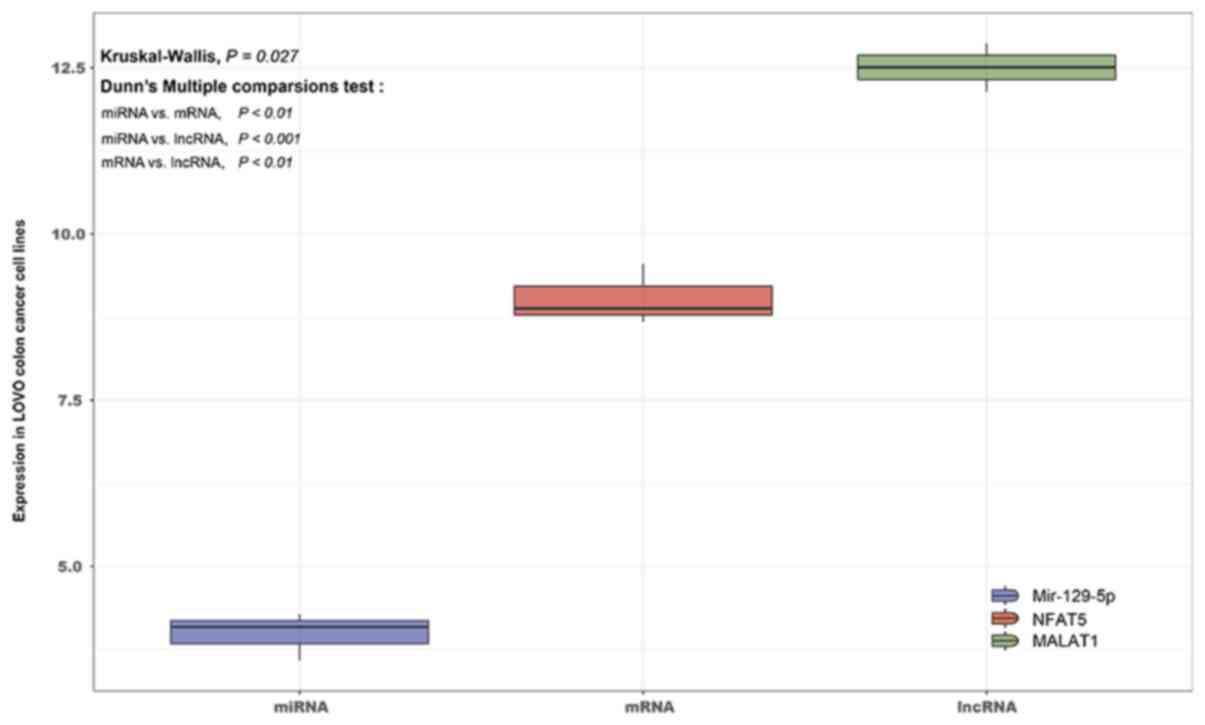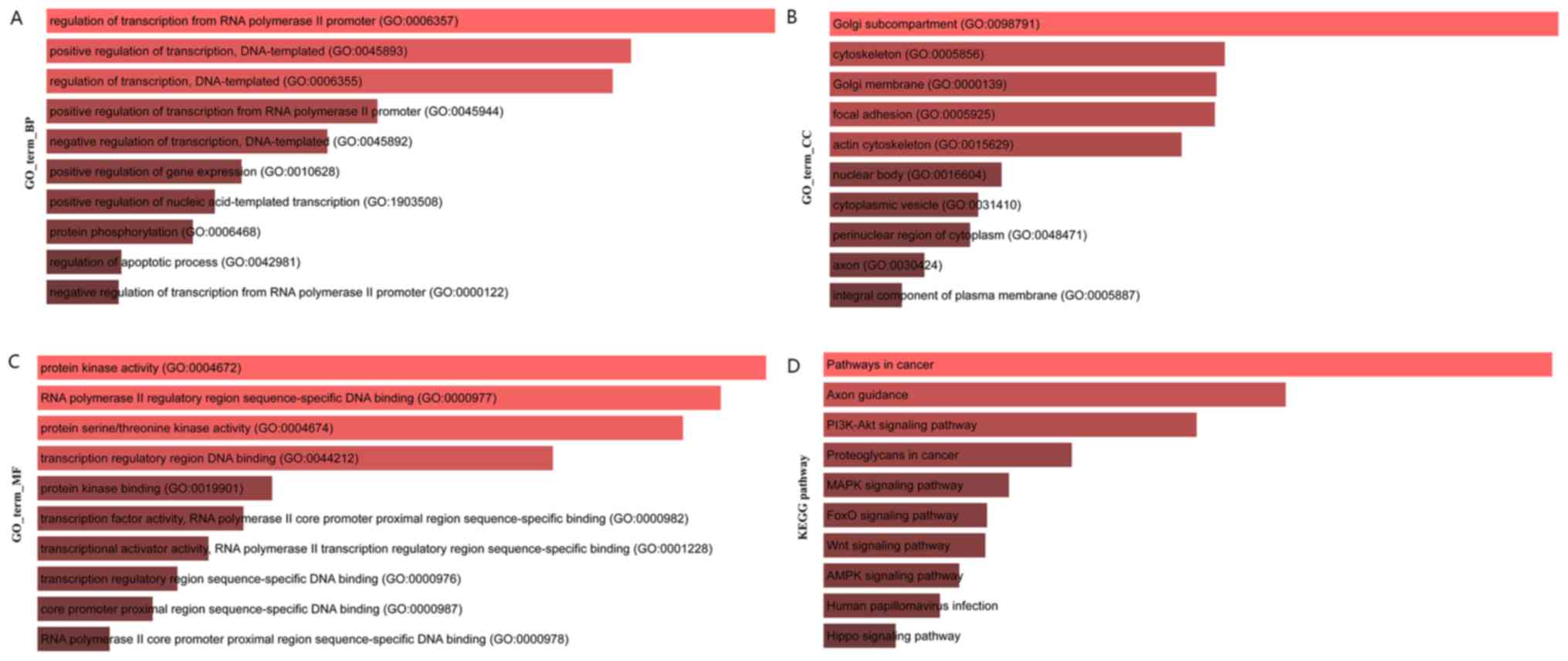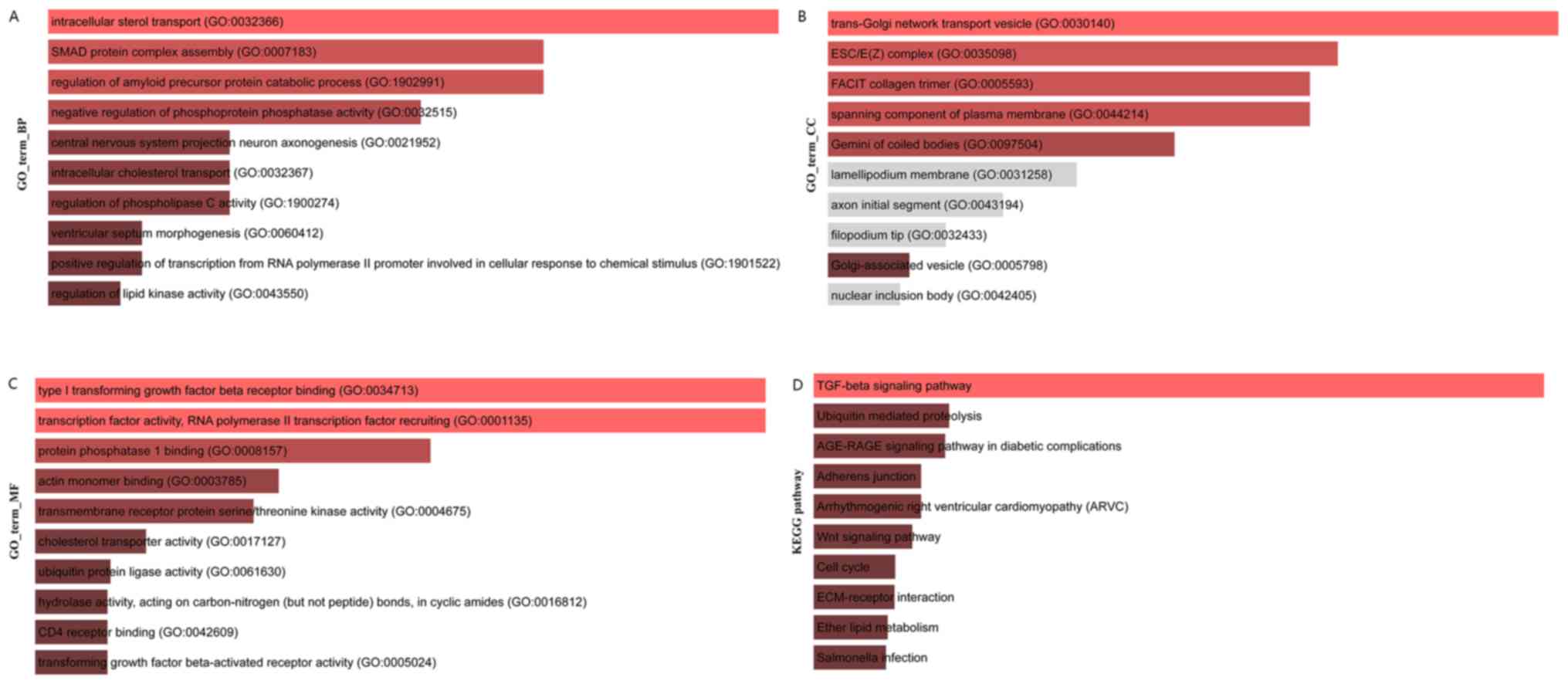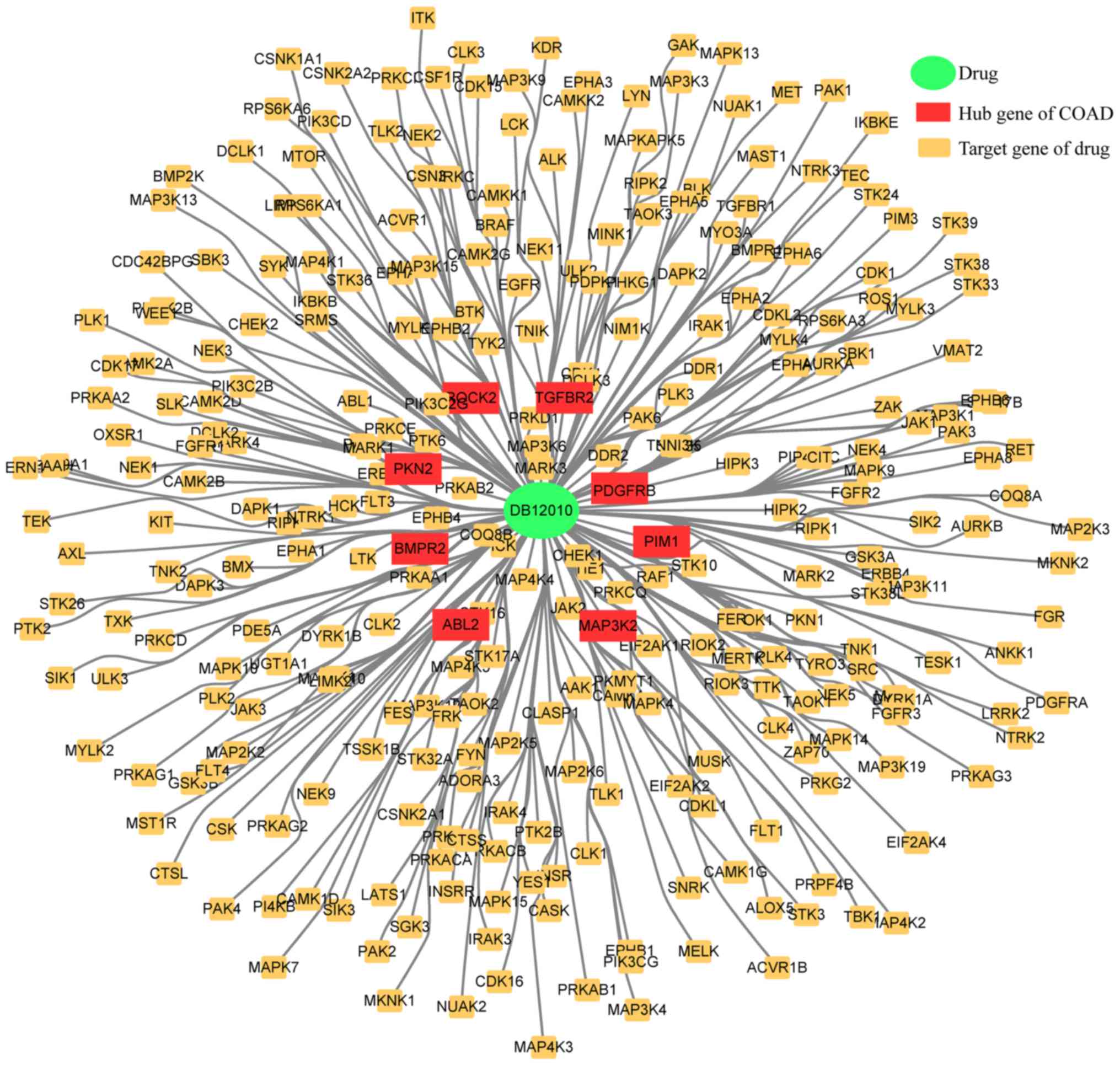|
1
|
Wong KE, Ngai SC, Chan KG, Lee LH, Goh BH
and Chuah LH: Curcumin nanoformulations for colorectal cancer: A
review. Front Pharmacol. 10:1522019. View Article : Google Scholar : PubMed/NCBI
|
|
2
|
Edwards BK, Ward E, Kohler BA, Eheman C,
Zauber AG, Anderson RN, Jemal A, Schymura MJ, Lansdorp-Vogelaar I,
Seeff LC, et al: Annual report to the nation on the status of
cancer, 1975–2006, featuring colorectal cancer trends and impact of
interventions (risk factors, screening, and treatment) to reduce
future rates. Cancer. 116:544–573. 2010. View Article : Google Scholar : PubMed/NCBI
|
|
3
|
Hao Y, Wang Y, Qi M, He X, Zhu Y and Hong
J: Risk factors for recurrent colorectal polyps. Gut Liver.
2019.(Epub ahead of print). View
Article : Google Scholar
|
|
4
|
Pohl C, Hombach A and Kruis W: Chronic
inflammatory bowel disease and cancer. Hepatogastroenterology.
47:57–70. 2000.PubMed/NCBI
|
|
5
|
Mehta A and Patel BM: Therapeutic
opportunities in colon cancer: Focus on phosphodiesterase
inhibitors. Life Sci. 230:150–161. 2019. View Article : Google Scholar : PubMed/NCBI
|
|
6
|
Yu C and Zhang Y: Development and
validation of a prognostic nomogram for early onset colon cancer.
Biosci Rep. 36:BSR201817812019. View Article : Google Scholar
|
|
7
|
Salmena L, Poliseno L, Tay Y, Kats L and
Pandolfi PP: A ceRNA hypothesis: The rosetta stone of a hidden RNA
language? Cell. 146:353–358. 2011. View Article : Google Scholar : PubMed/NCBI
|
|
8
|
Zhong Y, Du Y, Yang X, Mo Y, Fan C, Xiong
F, Ren D, Ye X, Li C, Wang Y, et al: Circular RNAs function as
ceRNAs to regulate and control human cancer progression. Mol
Cancer. 17:792018. View Article : Google Scholar : PubMed/NCBI
|
|
9
|
Wang Z, Xu P, Chen B, Zhang Z, Zhang C,
Zhan Q, Huang S, Xia ZA and Peng W: Identifying
circRNA-associated-ceRNA networks in the hippocampus of
Aβ1-42-induced Alzheimer's disease-like rats using microarray
analysis. Aging (Albany NY). 10:775–788. 2018. View Article : Google Scholar : PubMed/NCBI
|
|
10
|
Xing Q, Huang Y, Wu Y, Ma L and Cai B:
Integrated analysis of differentially expressed profiles and
construction of a competing endogenous long non-coding RNA network
in renal cell carcinoma. PeerJ. 6:e51242018. View Article : Google Scholar : PubMed/NCBI
|
|
11
|
Wang P, Li X, Gao Y, Guo Q, Ning S, Zhang
Y, Shang S, Wang J, Wang Y, Zhi H, et al: LnCeVar: A comprehensive
database of genomic variations that disturb ceRNA network
regulation. Nucleic Acids Res. 48:D111–D117. 2020.PubMed/NCBI
|
|
12
|
Yao Y, Zhang T, Qi L, Zhou C, Wei J, Feng
F, Liu R and Sun C: Integrated analysis of co-expression and ceRNA
network identifies five lncRNAs as prognostic markers for breast
cancer. J Cell Mol Med. 23:8410–8419. 2019. View Article : Google Scholar : PubMed/NCBI
|
|
13
|
Wu Y, Deng Y, Guo Q, Zhu J, Cao L, Guo X,
Xu F, Weng W, Ju X and Wu X: Long non-coding RNA SNHG6 promotes
cell proliferation and migration through sponging miR-4465 in
ovarian clear cell carcinoma. J Cell Mol Med. 23:5025–5036. 2019.
View Article : Google Scholar : PubMed/NCBI
|
|
14
|
Liu W and Wang X: Prediction of functional
microRNA targets by integrative modeling of microRNA binding and
target expression data. Genome Biol. 20:182019. View Article : Google Scholar : PubMed/NCBI
|
|
15
|
Jeggari A, Marks DS and Larsson E:
miRcode: A map of putative microRNA target sites in the long
non-coding transcriptome. Bioinformatics. 28:2062–2063. 2012.
View Article : Google Scholar : PubMed/NCBI
|
|
16
|
Paraskevopoulou MD, Vlachos IS, Karagkouni
D, Georgakilas G, Kanellos I, Vergoulis T, Zagganas K, Tsanakas P,
Floros E, Dalamagas T and Hatzigeorgiou AG: DIANA-LncBase v2:
Indexing microRNA targets on non-coding transcripts. Nucleic Acids
Res. 44:D231–D238. 2016. View Article : Google Scholar : PubMed/NCBI
|
|
17
|
Shannon P, Markiel A, Ozier O, Baliga NS,
Wang JT, Ramage D, Amin N, Schwikowski B and Ideker T: Cytoscape: A
software environment for integrated models of biomolecular
interaction networks. Genome Res. 13:2498–2504. 2003. View Article : Google Scholar : PubMed/NCBI
|
|
18
|
Chen EY, Tan CM, Kou Y, Duan Q, Wang Z,
Meirelles GV, Clark NR and Ma'ayan A: Enrichr: Interactive and
collaborative HTML5 gene list enrichment analysis tool. BMC
Bioinformatics. 14:1282013. View Article : Google Scholar : PubMed/NCBI
|
|
19
|
Chandrashekar DS, Bashel B, Balasubramanya
SAH, Creighton CJ, Ponce-Rodriguez I, Chakravarthi BVSK and
Varambally S: UALCAN: A portal for facilitating tumor subgroup gene
expression and survival analyses. Neoplasia. 19:649–658. 2017.
View Article : Google Scholar : PubMed/NCBI
|
|
20
|
Tang Z, Li C, Kang B, Gao G, Li C and
Zhang Z: GEPIA: A web server for cancer and normal gene expression
profiling and interactive analyses. Nucleic Acids Res. 45:W98–W102.
2017. View Article : Google Scholar : PubMed/NCBI
|
|
21
|
Wu Q, Meng WY, Jie Y and Zhao H: lncRNA
MALAT1 induces colon cancer development by regulating
miR-129-5p/HMGB1 axis. J Cell Physiol. 233:6750–6757. 2018.
View Article : Google Scholar : PubMed/NCBI
|
|
22
|
King CE, Cuatrecasas M, Castells A,
Sepulveda AR, Lee JS and Rustgi AK: LIN28B promotes colon cancer
progression and metastasis. Cancer Res. 71:4260–4268. 2011.
View Article : Google Scholar : PubMed/NCBI
|
|
23
|
Wishart DS, Feunang YD, Guo AC, Lo EJ,
Marcu A, Grant JR, Sajed T, Johnson D, Li C, Sayeeda Z, et al:
DrugBank 5.0: A major update to the DrugBank database for 2018.
Nucleic Acids Res. 46:D1074–D1082. 2018. View Article : Google Scholar : PubMed/NCBI
|
|
24
|
Iyer MK, Niknafs YS, Malik R, Singhal U,
Sahu A, Hosono Y, Barrette TR, Prensner JR, Evans JR, Zhao S, et
al: The landscape of long noncoding RNAs in the human
transcriptome. Nat Genet. 47:199–208. 2015. View Article : Google Scholar : PubMed/NCBI
|
|
25
|
Feng SD, Yang JH, Yao CH, Yang SS, Zhu ZM,
Wu D, Ling HY and Zhang L: Potential regulatory mechanisms of
lncRNA in diabetes and its complications. Biochem Cell Biol.
95:361–367. 2017. View Article : Google Scholar : PubMed/NCBI
|
|
26
|
Greco S, Gaetano C and Martelli F: Long
noncoding competing endogenous RNA networks in age-associated
cardiovascular diseases. Int J Mol Sci. 20:E30792019. View Article : Google Scholar : PubMed/NCBI
|
|
27
|
Peng WX, Koirala P and Mo YY:
LncRNA-mediated regulation of cell signaling in cancer. Oncogene.
36:5661–5667. 2017. View Article : Google Scholar : PubMed/NCBI
|
|
28
|
Ke S, Yang Z, Yang F, Wang X, Tan J and
Liao B: Long noncoding RNA NEAT1 aggravates Aβ-induced neuronal
damage by targeting miR-107 in Alzheimer's disease. Yonsei Med J.
60:640–650. 2019. View Article : Google Scholar : PubMed/NCBI
|
|
29
|
Kulkarni S, Lied A, Kulkarni V, Rucevic M,
Martin MP, Walker-Sperling V, Anderson SK, Ewy R, Singh S, Nguyen
H, et al: CCR5AS lncRNA variation differentially regulates CCR5,
influencing HIV disease outcome. Nat Immunol. 20:824–834. 2019.
View Article : Google Scholar : PubMed/NCBI
|
|
30
|
Li N, Liu Y and Cai J: lncRNA MIR155HG
regulates M1/M2 macrophage polarization in chronic obstructive
pulmonary disease. Biomed Pharmacother. 117:1090152019. View Article : Google Scholar : PubMed/NCBI
|
|
31
|
Yang F, Li XF, Cheng LN and Li XL: Long
non-coding RNA CRNDE promoted cell apoptosis by suppressing miR-495
in inflammatory bowel disease. Exp Cell Res. 382:1114842019.
View Article : Google Scholar : PubMed/NCBI
|
|
32
|
Pan Z, Choi S, Ouadid-Ahidouch H, Yang JM,
Beattie JH and Korichneva I: Zinc transporters and dysregulated
channels in cancers. Front Biosci (Landmark Ed). 22:623–643. 2017.
View Article : Google Scholar : PubMed/NCBI
|
|
33
|
Gartmann L, Wex T, Grungreiff K, Reinhold
D, Kalinski T, Malfertheiner P and Schütte K: Expression of zinc
transporters ZIP4, ZIP14 and ZnT9 in hepatic carcinogenesis-An
immunohistochemical study. J Trace Elem Med Biol. 49:35–42. 2018.
View Article : Google Scholar : PubMed/NCBI
|
|
34
|
Kolenko V, Teper E, Kutikov A and Uzzo R:
Zinc and zinc transporters in prostate carcinogenesis. Nat Rev
Urol. 10:219–226. 2013. View Article : Google Scholar : PubMed/NCBI
|
|
35
|
Tran MH, Seo E, Min S, Nguyen QT, Choi J,
Lee UJ, Hong SS, Kang H, Mansukhani A, Jou I and Lee SY:
NEDD4-induced degradative ubiquitination of phosphatidylinositol
4-phosphate 5-kinase α and its implication in breast cancer cell
proliferation. J Cell Mol Med. 22:4117–4129. 2018. View Article : Google Scholar : PubMed/NCBI
|
|
36
|
Rodgers SJ, Ferguson DT, Mitchell CA and
Ooms LM: Regulation of PI3K effector signalling in cancer by the
phosphoinositide phosphatases. Biosci Rep. 37:BSR201604322017.
View Article : Google Scholar : PubMed/NCBI
|
|
37
|
Yang J, Yang C, Zhang S, Mei Z, Shi M, Sun
S, Shi L, Wang Z, Wang Y, Li Z and Xie C: ABC294640, a sphingosine
kinase 2 inhibitor, enhances the antitumor effects of TRAIL in
non-small cell lung cancer. Cancer Biol Ther. 16:1194–1204. 2015.
View Article : Google Scholar : PubMed/NCBI
|
|
38
|
Wang J, Zhang B, Wu H, Cai J, Sui X, Wang
Y, Li H, Qiu Y, Wang T, Chen Z, et al: CD51 correlates with the
TGF-beta pathway and is a functional marker for colorectal cancer
stem cells. Oncogene. 36:1351–1363. 2017. View Article : Google Scholar : PubMed/NCBI
|
|
39
|
Nakano M, Kikushige Y, Miyawaki K,
Kunisaki Y, Mizuno S, Takenaka K, Tamura S, Okumura Y, Ito M,
Ariyama H, et al: Dedifferentiation process driven by TGF-beta
signaling enhances stem cell properties in human colorectal cancer.
Oncogene. 38:780–793. 2019. View Article : Google Scholar : PubMed/NCBI
|
|
40
|
Bao Y, Wang L, Shi L, Yun F, Liu X, Chen
Y, Chen C, Ren Y and Jia Y: Transcriptome profiling revealed
multiple genes and ECM-receptor interaction pathways that may be
associated with breast cancer. Cell Mol Biol Lett. 24:382019.
View Article : Google Scholar : PubMed/NCBI
|
|
41
|
Zhang HJ, Tao J, Sheng L, Hu X, Rong RM,
Xu M and Zhu TY: RETRACTED: Twist2 promotes kidney cancer cell
proliferation and invasion via regulating ITGA6 and CD44 expression
in the ECM-Receptor-Interaction pathway. Biomed Pharmacother.
81:453–459. 2016. View Article : Google Scholar : PubMed/NCBI
|
|
42
|
Song L, Li ZY, Liu WP and Zhao MR:
Crosstalk between Wnt/β-catenin and Hedgehog/Gli signaling pathways
in colon cancer and implications for therapy. Cancer Biol Ther.
16:1–7. 2015. View Article : Google Scholar : PubMed/NCBI
|
|
43
|
Seguella L, Capuano R, Pesce M, Annunziata
G, Pesce M, de Conno B, Sarnelli G, Aurino L and Esposito G: S100B
protein stimulates proliferation and angiogenic mediators release
through RAGE/pAkt/mTOR pathway in human colon adenocarcinoma Caco-2
cells. Int J Mol Sci. 20:E32402019. View Article : Google Scholar : PubMed/NCBI
|
|
44
|
Hanahan D and Weinberg RA: The hallmarks
of cancer. Cell. 100:57–70. 2000. View Article : Google Scholar : PubMed/NCBI
|
|
45
|
Hanahan D and Weinberg RA: Hallmarks of
cancer: The next generation. Cell. 144:646–674. 2011. View Article : Google Scholar : PubMed/NCBI
|
|
46
|
Arun G, Diermeier SD and Spector DL:
Therapeutic targeting of long non-coding RNAs in cancer. Trends Mol
Med. 24:257–277. 2018. View Article : Google Scholar : PubMed/NCBI
|
|
47
|
Ji P, Diederichs S, Wang W, Böing S,
Metzger R, Schneider PM, Tidow N, Brandt B, Buerger H, Bulk E, et
al: MALAT-1, a novel noncoding RNA, and thymosin beta4 predict
metastasis and survival in early-stage non-small cell lung cancer.
Oncogene. 22:8031–8041. 2003. View Article : Google Scholar : PubMed/NCBI
|
|
48
|
Zhuang M, Zhao S, Jiang Z, Wang S, Sun P,
Quan J, Yan D and Wang X: MALAT1 sponges miR-106b-5p to promote the
invasion and metastasis of colorectal cancer via SLAIN2 enhanced
microtubules mobility. EBioMedicine. 41:286–298. 2019. View Article : Google Scholar : PubMed/NCBI
|
|
49
|
Wei GH and Wang X: lncRNA MEG3 inhibit
proliferation and metastasis of gastric cancer via p53 signaling
pathway. Eur Rev Med Pharmacol Sci. 21:3850–3856. 2017.PubMed/NCBI
|
|
50
|
Lyu Y, Lou J, Yang Y, Feng J, Hao Y, Huang
S, Yin L, Xu J, Huang D, Ma B, et al: Dysfunction of the WT1-MEG3
signaling promotes AML leukemogenesis via p53-dependent and
-independent pathways. Leukemia. 31:2543–2551. 2017. View Article : Google Scholar : PubMed/NCBI
|
|
51
|
Bracken CP, Scott HS and Goodall GJ: A
network-biology perspective of microRNA function and dysfunction in
cancer. Nat Rev Genet. 17:719–732. 2016. View Article : Google Scholar : PubMed/NCBI
|
|
52
|
Chan JJ and Tay Y: Noncoding RNA: RNA
regulatory networks in cancer. Int J Mol Sci. 19:E13102018.
View Article : Google Scholar : PubMed/NCBI
|
|
53
|
Gebert LFR and MacRae IJ: Regulation of
microRNA function in animals. Nat Rev Mol Cell Biol. 20:21–37.
2019. View Article : Google Scholar : PubMed/NCBI
|
|
54
|
Ishikawa D, Takasu C, Kashihara H, Nishi
M, Tokunaga T, Higashijima J, Yoshikawa K, Yasutomo K and Shimada
M: The significance of microRNA-449a and its potential target HDAC1
in patients with colorectal cancer. Anticancer Res. 39:2855–2860.
2019. View Article : Google Scholar : PubMed/NCBI
|
|
55
|
Jiang L and Hermeking H: miR-34a and
miR-34b/c suppress intestinal tumorigenesis. Cancer Res.
77:2746–2758. 2017. View Article : Google Scholar : PubMed/NCBI
|
|
56
|
Xu Q, Liu LZ, Qian X, Chen Q, Jiang Y, Li
D, Lai L and Jiang BH: miR-145 directly targets p70S6K1 in cancer
cells to inhibit tumor growth and angiogenesis. Nucleic Acids Res.
40:761–774. 2012. View Article : Google Scholar : PubMed/NCBI
|
|
57
|
Coppola JM, Bhojani MS, Ross BD and
Rehemtulla A: A small-molecule furin inhibitor inhibits cancer cell
motility and invasiveness. Neoplasia. 10:363–370. 2008. View Article : Google Scholar : PubMed/NCBI
|
|
58
|
Scamuffa N, Sfaxi F, Ma J, Lalou C, Seidah
N, Calvo F and Khatib AM: Prodomain of the proprotein convertase
subtilisin/kexin Furin (ppFurin) protects from tumor progression
and metastasis. Carcinogenesis. 35:528–536. 2014. View Article : Google Scholar : PubMed/NCBI
|
|
59
|
Chen M, Sastry SK and O'Connor KL: Src
kinase pathway is involved in NFAT5-mediated S100A4 induction by
hyperosmotic stress in colon cancer cells. Am J Physiol Cell
Physiol. 300:C1155–C1163. 2011. View Article : Google Scholar : PubMed/NCBI
|
|
60
|
Jauliac S, Lopez-Rodriguez C, Shaw LM,
Brown LF, Rao A and Toker A: The role of NFAT transcription factors
in integrin-mediated carcinoma invasion. Nat Cell Biol. 4:540–544.
2002. View
Article : Google Scholar : PubMed/NCBI
|
|
61
|
Plasterer C, Tsaih SW, Lemke A, Schilling
R, Dwinell M, Rau A, Auer P, Rui H and Flister MJ: Identification
of a rat mammary tumor risk locus that is syntenic with the
commonly amplified 8q12.1 and 8q22.1 regions in human breast cancer
patients. G3 (Bethesda). 9:1739–1743. 2019. View Article : Google Scholar : PubMed/NCBI
|
|
62
|
Zhang ZR, Zheng Y, Ruan BZ, et al:
Expression and subcellular localization of RRAGD-EGFP fusion
protein in MDA-MB-436 cells. Letters in Biotechnology. 28:639–642.
2017.(In Chinese).
|
|
63
|
Polson HE, de Lartigue J, Rigden DJ,
Reedijk M, Urbé S, Clague MJ and Tooze SA: Mammalian Atg18 (WIPI2)
localizes to omegasome-anchored phagophores and positively
regulates LC3 lipidation. Autophagy. 6:506–522. 2010. View Article : Google Scholar : PubMed/NCBI
|
|
64
|
Amaravadi R, Kimmelman AC and White E:
Recent insights into the function of autophagy in cancer. Genes
Dev. 30:1913–1930. 2016. View Article : Google Scholar : PubMed/NCBI
|
|
65
|
Wu C, Zhu X, Tao K, Liu W, Ruan T, Wan W,
Zhang C and Zhang W: MALAT1 promotes the colorectal cancer
malignancy by increasing DCP1A expression and miR203
downregulation. Mol Carcinog. 57:1421–1431. 2018. View Article : Google Scholar : PubMed/NCBI
|
|
66
|
Suljagic M, Longo PG, Bennardo S, Perlas
E, Leone G, Laurenti L and Efremov DG: The Syk inhibitor
fostamatinib disodium (R788) inhibits tumor growth in the Eµ-TCL1
transgenic mouse model of CLL by blocking antigen-dependent B-cell
receptor signaling. Blood. 116:4894–4905. 2010. View Article : Google Scholar : PubMed/NCBI
|
|
67
|
Bajpai M: Fostamatinib, a Syk inhibitor
prodrug for the treatment of inflammatory diseases. IDrugs.
12:174–185. 2009.PubMed/NCBI
|















